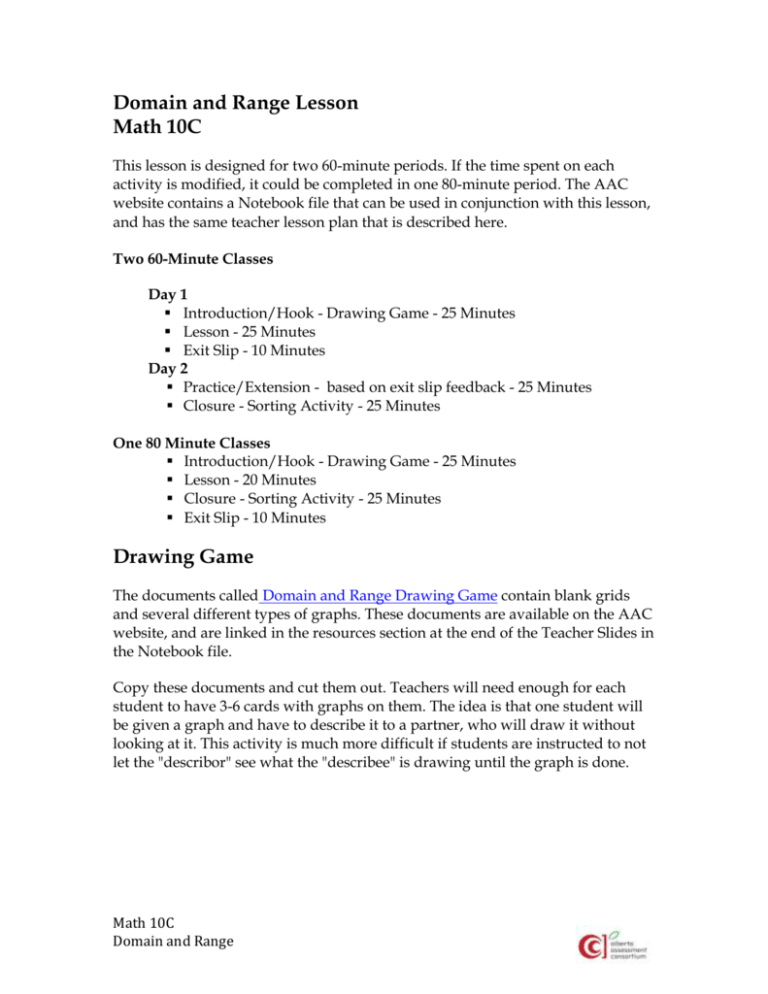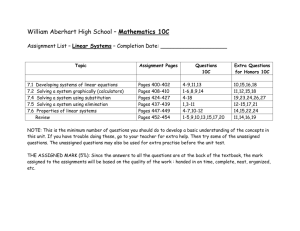Domain_and_Range_Lesson
advertisement

Domain and Range Lesson Math 10C This lesson is designed for two 60-minute periods. If the time spent on each activity is modified, it could be completed in one 80-minute period. The AAC website contains a Notebook file that can be used in conjunction with this lesson, and has the same teacher lesson plan that is described here. Two 60-Minute Classes Day 1 Introduction/Hook - Drawing Game - 25 Minutes Lesson - 25 Minutes Exit Slip - 10 Minutes Day 2 Practice/Extension - based on exit slip feedback - 25 Minutes Closure - Sorting Activity - 25 Minutes One 80 Minute Classes Introduction/Hook - Drawing Game - 25 Minutes Lesson - 20 Minutes Closure - Sorting Activity - 25 Minutes Exit Slip - 10 Minutes Drawing Game The documents called Domain and Range Drawing Game contain blank grids and several different types of graphs. These documents are available on the AAC website, and are linked in the resources section at the end of the Teacher Slides in the Notebook file. Copy these documents and cut them out. Teachers will need enough for each student to have 3-6 cards with graphs on them. The idea is that one student will be given a graph and have to describe it to a partner, who will draw it without looking at it. This activity is much more difficult if students are instructed to not let the "describor" see what the "describee" is drawing until the graph is done. Math 10C Domain and Range The drawing game can be played in two different ways. Teachers should decide which format would work best for their class. The non-competitive version can be done more quickly, if time is a factor. Competitive Version Put the students in teams of 2 and have them compete against another pair. Give each group of 4 the entire set of completed graphs, cut out, shuffled, and face down. Give each student one of the sheets with all the blank grids on it. Have students take turns pulling the top card, and describing it to their partner. Put a 1-minute timer up on the board. The pair sitting out in that round will judge and decide if the pair doing the drawing did well enough to earn a point. Try to make sure that the person describing the graph can't see what his partner is drawing. It’s much more challenging that way. Play 12 rounds of 1 minute each, so that each student gets to describe 3 times and draw 3 times. Non-Competitive Version Pair students off and give them each 3 or 4 completed graphs and the sheet of blank grids. Set a timer for 1 minute, and have partner 1 describe a graph, while partner 2 draws. Try to make sure that the person describing the graph can't see what his partner is drawing. It’s much more challenging that way. When the time is up, the pair can look at the original and the drawing and see how accurately the drawer was able to replicate the graph based only on the verbal description from the partner. Have the partners switch roles, and give them each the opportunity to draw and describe 3 or 4 times. The Lesson Math 10C Domain and Range Begin the lesson by having students discuss their drawing experience. Specifically, ask them what words and vocabulary they found themselves using to describe the graphs to their partner. Write these words on the board or blank Notebook slide. Students will likely come up with words like arrow, axis, quadrant, stops, keeps going, points, curves, straight, ends, begins, lowest, highest, farthest right, farthest left and many more. This language leads nicely into domain and range. Math 10C Domain and Range Give each student two different coloured pencil crayons for the next part of the lesson. Making Domain and Range Visual: One way to help students see domain and range more clearly is to teach them to draw to the y-axis from the highest and lowest points, and colour the y-axis in that same colour to highlight the range. Then they use the other colour to go from the farthest left and farthest right points on the graph and draw to the x-axis. This strategy makes the domain and range stand out for the students. The student slides in the Notebook file contain screen shots of all the graphs that were provided in the Graph Drawing Game. The teacher should show students how to find the domain and range for several of these, and then allow the students to find the domain and range on their own for several more. There are far more graphs provided than should be done in class. They have been sorted into four broad categories: Graphs that stop at both ends Graphs that go on in one direction Graphs that go on in both directions Sets of points Begin with having students give verbal descriptions of the domain and range, and progress to the appropriate notation, as illustrated below. Math 10C Domain and Range Math 10C Domain and Range Go through several examples on the student slides in the Notebook file, or on the board. Far more are provided than should be needed for most classes. Most classes should be ready to move on after 2-3 examples and a chance to practice one on their own. Once the lesson is completed, move on to the Exit Slip (60 Minute class) or the matching activity (80 Minute Class). Closing Activity - Matching Game The closing activity is a Matching Game. The documents called Domain and Range Matching Activity, available on the AAC website, contain a set of cards that can be copied and cut out. Half the cards show a domain and range, and the other half have corresponding relations on them. Depending on the time available, teachers could do one of two things with these cards. Option 1 Give each student one card, and have them match up with the person who has the corresponding card. Option 2 Math 10C Domain and Range Group the students into groups of 3 or 4. Give each group an entire set of cards and ask them to pair all the cards off, working as a group. Math 10C Domain and Range Exit Slip Students can be given an exit slip at the end of the class. An exit slip for this lesson is provided on the AAC website. The exit slip gives teachers and students feedback about how the lesson went. It allows students a risk-free way to see if they understood the lesson. It gives teachers information that can shape the next day's instruction. The exit slip could be use to group the students for the start of the next class. Typically, three piles are sufficient, and the exit slips do not need to be marked or graded in any way. The three piles would be: Those that demonstrated good understanding of the lesson. Those that demonstrated some understanding, but need a little more work. Those that demonstrated they need more help or time to master the material. Some teachers use these groupings and exit slips as a way to reduce the amount of homework they assign. The exit slip is one opportunity for students to practice, and the start of the next day's class is a second opportunity. Instead of spending the first 20 minutes of class going over homework questions, the teacher groups the students according to the information gleaned from the exit slip. Once grouped, the teacher can have the students do practice questions in class. Based on the feedback and the three groups described above, students could be assigned questions from whichever resource is used in class, according to the following guidelines. Group that showed mastery Given questions and problems from the student resource that are challenging and extend their thinking. Math 10C Domain and Range Group that showed some understanding Asked to fix their errors on the exit slips, then given some basic practice questions, followed by some more challenging problems. Group that showed a lack of understanding Will work with the teacher to fix errors. The teacher may need to re-teach this group, or show them some alternative strategies. This group should still be expected to progress to the more challenging problems. Resources Required Cards for Domain and Range Drawing Game Blank Grids for Domain and Range Drawing Game Pencil Crayons or Highlighters Cards for Matching Game Exit Slips Math 10C Domain and Range






